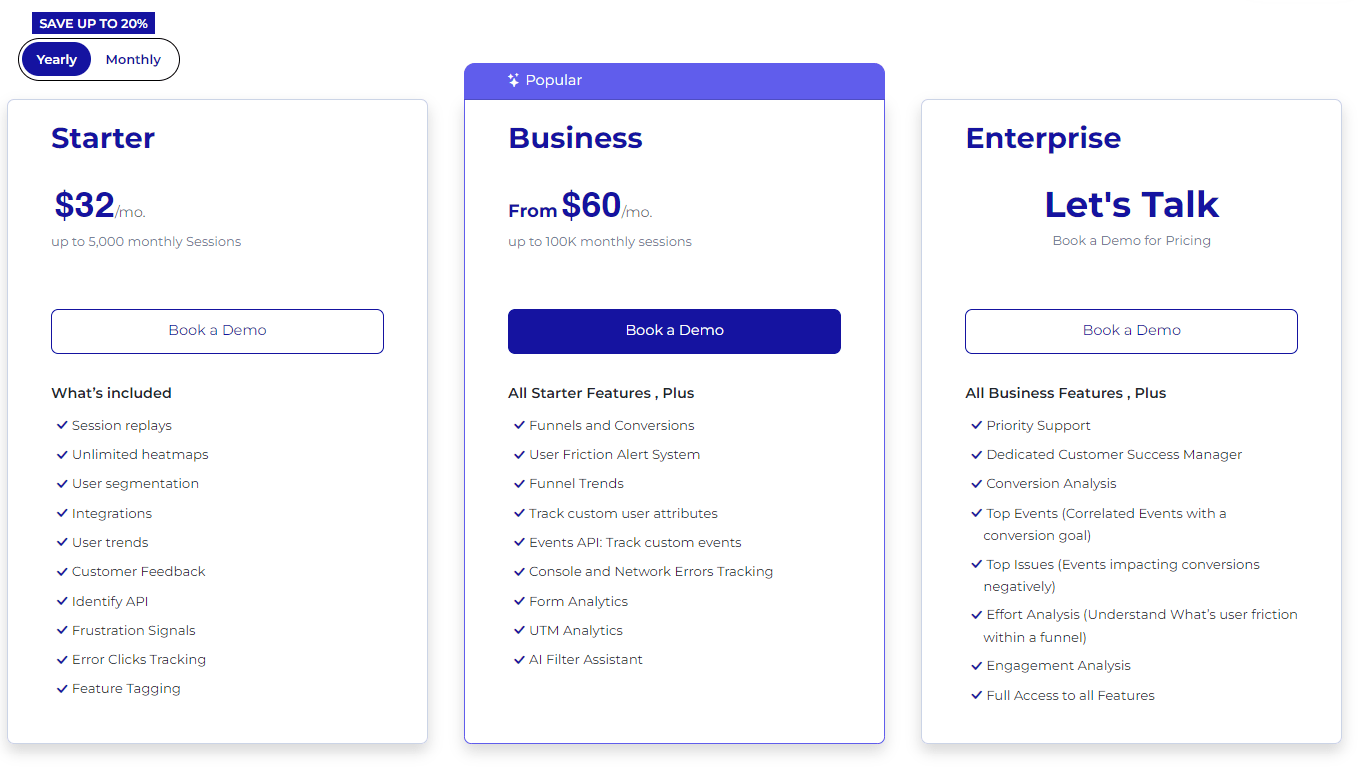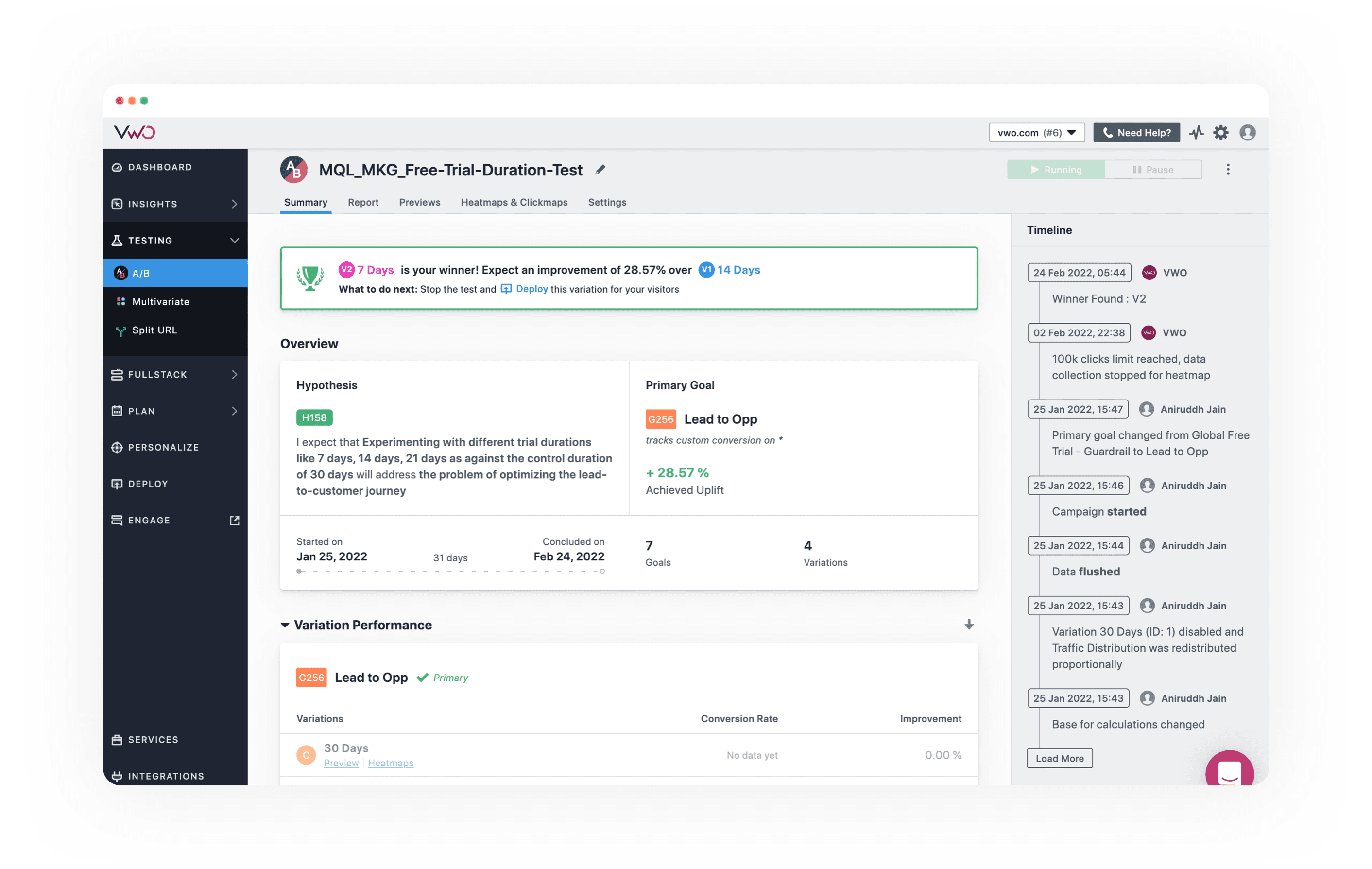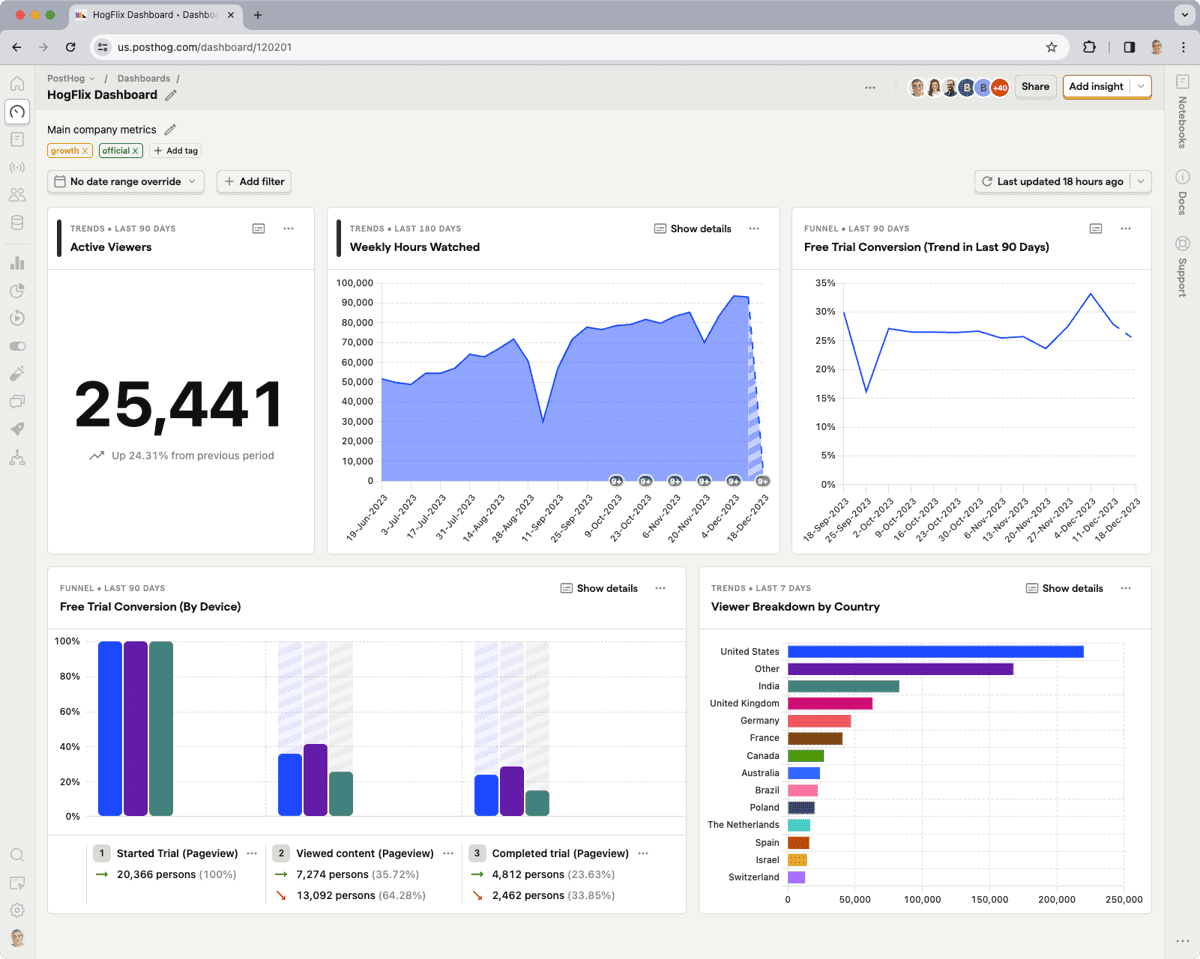Are you looking to optimize your website's performance but unsure if VWO is the right choice? You're in luck! We've compiled...

50 Close-Ended Questions Examples (+ Free Survey Guide)
Close-ended questions allow you to create surveys that are easy to answer for respondents. In turn, it will be easier for you to collect quantitative data and conduct statistical analysis on any particular aspect you want to study.
Unlike open-ended questions, these questions only require a one-word answer or a selection from a pre-determined list of answer choices. They're easy, quick, and extremely useful when you want to collect data on a large scale.
Still, these questions require careful analysis and have certain limitations you should consider. In this guide, we will explore the different types of close-ended questions, some examples for each category, and the pros and cons of close-ended questions from a marketing perspective.
What are Close Ended Questions?
Close-ended questions offer survey respondents a predetermined list of answers to choose from. Usually, a customer answers these questions with a single-word answer, such as "yes/no" "true/false" or "agree or disagree."
Closed-ended questions are designed to gather survey responses that are easy to quantify and analyze. For example, asking your customers, "Do you like Product A?" and offering a simple "yes" or "no" selection gives you an easy method to see how many customers like your product.
Closed-Ended Questions vs. Open-Ended Questions
A closed-ended question is structured so that the respondent can choose from a list of options, making them particularly useful for efficient and simple quantitative analysis.
An open-ended question, on the other hand, allows respondents to answer freely in their own words, offering richer, more detailed insights. These questions are invaluable in collecting qualitative data where depth, detail, and the exploration of new ideas are essential.
Here are the key differences between close-ended questions and open-ended questions at a glance:
| Open-Ended Question | Closed-Ended Question |
| Allows participants to answer in their own words | Limited and pre-determined answer choices |
| Focuses on collecting qualitative data | Collects quantitative data |
| Requires more time to answer | Easy to answer |
| Responses may be tedious to analyze | Provides easily quantifiable data |
When Should You Use Close-Ended Questions?
Open-ended questions and closed-ended questions have their unique pros and cons. Deciding which type you should use will depend on several factors, such as:
- The type of data you want to collect
- Your goals
- Resources available
- Your target audience
Based on these factors, asking closed-ended questions is best applicable when:
You're Collecting Quantitative Data
Quantitative data collection aims to gather measurable, numerical insights. Closed-ended questions are perfect for this task because they provide structured responses that you can easily count and analyze, which is why we use them as the foundation of statistical analysis techniques applied to surveys.
Whether it's tallying yes/no responses or aggregating ratings on a scale, these questions convert subjective opinions into objective numbers, making it straightforward to quantify trends, preferences, and behaviors.
You Want to Collect Survey Responses at Scale
When conducting surveys, especially those targeting a broad audience, efficiency and scalability are key. Closed-ended questions allow respondents to choose from a set of predefined answers quickly, significantly reducing the time and effort required to complete the survey.
This factor is crucial for achieving a high response rate in large-scale surveys, as participants are more likely to complete the survey if it's perceived as quick and straightforward.
You're Looking For a Specific Set of Responses
In some market research scenarios, you might be seeking information that falls within specific parameters or looking to validate a hypothesis. Closed-ended questions help you direct the focus of your survey to the precise data points you're interested in.
For example, a company wants to determine how much their customers spend on groceries monthly. Instead of letting participants answer freely, the survey will offer a set of fixed responses to keep the data simple:
- Less than $100
- $100-$200
- $200-$300
- More than $300
By limiting responses to a predefined set of options, you can ensure that the collected data is directly relevant to your research questions, making it easier to draw meaningful conclusions.
You Want to Make the Survey Easy to Answer
It's important to understand that people are busy, and most individuals will rarely take the time to answer a complicated survey.
With that in mind, you want to use closed-ended questions to make surveys more user-friendly. These questions eliminate the need for respondents to formulate their own answers, which can sometimes be a barrier to participation, especially for those who may find open-ended questions daunting or time-consuming.
50 Close-Ended Questions Examples
Close-ended questions fall into five main categories, including dichotomous questions, multiple choice questions, rating scale questions, ranking order questions, and checklist-style questions. Let's elaborate on each question type and explore several examples:
1. Dichotomous Questions
Dichotomous questions are a subset of closed-ended questions where respondents are given two mutually exclusive options to choose from, typically "Yes" or "No", "True" or "False", or any other pair of opposite answers.
These questions are designed to elicit a clear, concise response, making them incredibly useful for surveys and research that require straightforward, binary quantifiable data. Include this type of question in your survey in situations where you need a clear distinction between two categories of responses for data analysis.
Examples of closed-ended dichotomous questions include:
- Have you ever purchased a product from our website?
- Yes
- No
- Do you agree with the new company policy on remote work?
- Agree
- Disagree
- Is this your first time attending our annual conference?
- Yes
- No
- Would you recommend our service to a friend or colleague?
- Yes
- No
- Are you currently employed?
- Yes
- No
- Do you own a smartphone?
- Yes
- No
- Is the information on our website easy to understand?
- Yes
- No
- Have you experienced any side effects after using the medication?
- Yes
- No
- Do you believe that climate change is a serious threat to our planet?
- Yes
- No
- Did you find our customer service representative helpful?
- Yes
- No
2. Multiple Choice Questions
Multiple-choice questions provide respondents with several options to choose from. Unlike dichotomous questions, which offer only two choices, these questions present a wider range of answers, typically three or more.
The options for multiple-choice questions usually represent different categories or preferences. This format allows for more nuanced data collection by capturing a variety of responses that can reflect differing opinions, behaviors, or characteristics among the participants.
- What is your age group?
- Under 18
- 18-24
- 25-34
- 35-44
- 45 and above
- How often do you use our product?
- Daily
- Weekly
- Monthly
- Rarely
- Never
- What is your primary reason for choosing our service?
- Quality
- Price
- Customer service
- Convenience
- Other (please specify)
- Which of the following best describes your employment status?
- Employed full-time
- Employed part-time
- Self-employed
- Unemployed
- Retired
- Student
- How satisfied are you with our customer service?
- Very satisfied
- Somewhat satisfied
- Neutral
- Somewhat dissatisfied
- Very dissatisfied
- What type of content do you prefer on our blog?
- How-to guides
- Industry news
- Case studies
- Interviews
- Opinion pieces
- Which social media platform do you use the most?
- Snapchat
- TikTok
- How did you hear about us?
- Online advertising
- Social media
- Word of mouth
- News article
- Other
- What is your highest level of education?
- Some high school
- High school graduate
- Some college
- College graduate
- Postgraduate degree
- For which of the following purposes do you primarily use our product?
- Personal use
- Business use
- Educational use
- Entertainment
- Other (please specify)
3. Rating Scale Questions
Rating scale questions ask respondents to rate a particular item, experience, or service on a predefined scale. These scales can vary in range, typically from 3 to 10 points, with each point on the scale representing a level of agreement, frequency, quality, or satisfaction.
Rating scales are highly versatile and can be customized to measure various factors such as importance, likelihood, satisfaction, and performance. They provide quantitative data that may be more meaningful than dichotomous or multiple-choice questions, allowing for a detailed analysis of opinions and behaviors.
- How satisfied were you with your recent purchase?
- 1 (Not at all satisfied)
- 2
- 3
- 4
- 5 (Very satisfied)
- On a scale from 1 to 10, how likely are you to recommend our services to a friend or colleague?
- 1 (Not likely at all)
- ...
- 10 (Extremely likely)
- Please rate the quality of our customer service.
- 1 (Poor)
- 2
- 3 (Average)
- 4
- 5 (Excellent)
- How important is price to you when choosing this type of service?
- 1 (Not important)
- 2
- 3 (Moderately important)
- 4
- 5 (Very important)
- Rate your level of agreement with the following statement: The product meets my needs.
- Strongly disagree
- Disagree
- Neither agree nor disagree
- Agree
- Strongly agree
- How often do you use our product?
- Never
- Rarely
- Sometimes
- Often
- Always
- Rate the ease of use of our online platform.
- Very difficult
- Difficult
- Neutral
- Easy
- Very easy
- How would you rate the value for money of the product?
- Very poor value
- Poor value
- Average value
- Good value
- Excellent value
- Please rate your overall experience with our website.
- Very unsatisfactory
- Unsatisfactory
- Neutral
- Satisfactory
- Very satisfactory
- How comfortable were you during your visit to our facility?
- Extremely uncomfortable
- Uncomfortable
- Neutral
- Comfortable
- Extremely comfortable
4. Ranking Order Questions
Ranking order questions ask respondents to arrange a list of items in a specific order based on their preference, importance, satisfaction, or any other criteria specified by the question.
This type of question can help you understand priorities and preferences among a set of options, as it forces respondents to make choices that reveal the relative importance or appeal of each item. Like rating scale questions, rank order questions are particularly useful for collecting customer feedback.
- Rank the following features in order of importance to you when purchasing a new smartphone. (1 being the most important)
- Camera quality
- Battery life
- Storage capacity
- Screen size
- Price
- Please rank these product categories based on your personal preference for receiving them as gifts. (1 being your most preferred)
- Books
- Electronics
- Clothing
- Gift cards
- Home goods
- Rank the following factors by how significantly they influence your decision to choose a restaurant. (1 being the most significant)
- Menu variety
- Price
- Location
- Ambiance
- Reviews
- Rank these customer service aspects in order of importance to you. (1 being the most important)
- Speed of service
- Friendliness of staff
- Knowledge of staff
- Availability of support
- Please rank these social media platforms based on how frequently you use them. (1 being the most frequently used)
- TikTok
- Rank the following types of holiday destinations in order of your preference. (1 being your most preferred)
- Beach
- Mountain
- City
- Countryside
- Adventure park
- Please rank these factors in order of their importance to you when choosing an employer. (1 being the most important)
- Salary
- Work-life balance
- Company culture
- Career advancement opportunities
- Location
- Rank the following online shopping factors according to how much they matter to you. (1 being the most important)
- Free shipping
- Product variety
- Price discounts
- User reviews
- Return policy
- Please rank these methods of learning new skills based on your personal preference. (1 being your most preferred)
- Online courses
- In-person workshops
- Reading books
- Mentorship
- Self-experimentation
- Rank the following environmental concerns based on how urgent you believe they are. (1 being the most urgent)
- Climate change
- Plastic pollution
- Deforestation
- Air quality
- Water scarcity
5. Checklist-Style Questions
Checklist-style questions are a form of survey question where respondents are presented with a list of answer options and asked to select all that apply to them.
Unlike ranking or rating questions, checklist-style questions do not require respondents to evaluate or prioritize the options. Instead, these questions are used to gather data on the presence or absence of certain attributes, behaviors, preferences, or experiences among a population. They are particularly useful for identifying patterns, trends, or similarities within a group.
- Which of the following social media platforms do you use regularly? (Select all that apply)
- TikTok
- Snapchat
- What types of content do you prefer to consume online? (Select all that apply)
- News articles
- Blogs
- Videos
- Podcasts
- E-books
- Webinars
- Which of the following features are important to you in a mobile app? (Select all that apply)
- User-friendly interface
- Fast loading times
- High-quality content
- Offline accessibility
- Regular updates
- Privacy and security
- What dietary restrictions do you follow? (Select all that apply)
- Vegetarian
- Vegan
- Gluten-free
- Dairy-free
- Nut-free
- Halal
- Kosher
- Which of the following activities interests you? (Select all that apply)
- Hiking
- Reading
- Cooking
- Photography
- Gaming
- Yoga
- Painting
- What factors influence your decision to purchase a product online? (Select all that apply)
- Price
- Brand reputation
- Reviews and ratings
- Free shipping
- Easy return policy
- Product variety
- Which of the following services have you used in the last month? (Select all that apply)
- Food delivery
- Ride-sharing
- Online banking
- Streaming services
- Telehealth appointments
- What types of emails would you like to receive from us? (Select all that apply)
- Special offers and discounts
- New product announcements
- Company news
- Tips and how-to guides
- Customer stories and testimonials
- Which of the following health and wellness practices do you engage in? (Select all that apply)
- Regular exercise
- Meditation
- Balanced diet
- Regular health check-ups
- Mindfulness practices
- What reasons do you have for visiting our website? (Select all that apply)
- To purchase products
- To browse new arrivals
- To compare prices
- To read product reviews
- To seek customer support
- To find inspiration
Advantages and Disadvantages of Using Closed-Ended Questions
At a glance, using close-ended questions is an easy and quick way to gather quantifiable data. Plus, there are plenty of scenarios where they are more applicable than open-ended questions. However, there are still drawbacks to this type of survey question.
Pros of Using Closed-Ended Questions
- Ease of Analysis: Survey responses are easy to quantify, making data analysis more straightforward. This is particularly beneficial for large datasets where manual analysis of responses to open-ended questions would be too tedious.
- Quick to Answer: Participants can quickly select an answer from pre-determined answer options, reducing the time it takes to complete the survey. This can help improve response rates as respondents are less likely to abandon the survey due to time constraints or survey fatigue.
- Standardization: Closed-ended questions ensure that all respondents have the same set of options, leading to better uniformity in the data collected.
- Less Ambiguity: By providing specific response options, closed-ended questions reduce the chances of ambiguity in responses. This can lead to more accurate data collection, as respondents are less likely to misinterpret the question.
Cons of Using Closed-Ended Questions
- Limited Depth of Insight: Closed-ended questions can restrict the depth of insight you can gain from a survey. Respondents are confined to the options provided, which may not fully capture their opinions or experiences.
- Potential for Bias: The way options are framed can introduce bias, influencing how respondents choose their answers. Additionally, the researcher's assumptions may be embedded in the choices provided, which may not align with the respondent's perspectives.
- Over-Simplification: Complex issues may be oversimplified into discrete options, which can lead to a loss of nuance in the data collected. This oversimplification can mask underlying trends or patterns in the data.
Know When to Use Close-Ended Questions
Close-ended survey questions are an essential tool for gaining direct insight into specific aspects that you want to study, such as customer preferences and backgrounds. Still, it's crucial to understand that limiting possible answers can make survey findings less meaningful if you do it in scenarios where you should be asking open-ended questions.
Use this guide to create surveys that align with your research objectives and gather more valuable insights. For customer feedback or website user research, use FullSession to make data collection easier.
FullSession's customer feedback tools let you create in-app survey questions to collect instant feedback on your website. Plus, you get access to other powerful tools when you sign up with FullSession:
- Interactive heat maps
- Session recordings and replays
- Market segmentation and filtering
FullSession Pricing Plans

The FullSession platform offers a 14-day free trial. It provides two paid plans—Basic and Business. Here are more details on each plan.
- The Starter plan costs $39/month or $32/year and allows you to monitor up to 5,000 monthly sessions with up to 6 months of data storage.
- The Business plan costs $75/month or $60/year and helps you to track and analyze up to 100,000 monthly sessions with up to 12 months of data storage.
- The Enterprise plan has custom pricing and offers customizable sessions plus full access to all features.
Install Your First Website Survey Form Right Now
It takes less than 5 minutes to set up your first website or app survey form, with FullSession, and it's completely free!
FAQs About Close-Ended Questions
Can closed-ended questions be used for all types of research?
While versatile, they are best suited for quantitative research and situations where specific, comparable data is required.
How can I ensure my close-ended questions are effective?
Keep them clear and concise, and ensure the response options cover all likely answers without overlapping.
Are close-ended questions biased?
They can be, especially if the response options are leading or limiting. It's crucial to design them with care to minimize bias.




